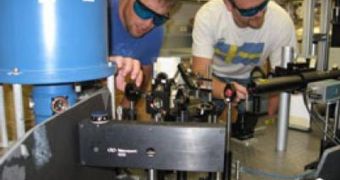Experts at the University of California in San Diego (UCSD) have recently reaffirmed their role as leading experts in the field of electronics. Last summer, they created an integrated circuit capable of working at 1.5 degrees Kelvin above absolute zero. Those temperatures are colder than most places in the Universe, and can only be achieved under very special conditions. Now, the team has announced the creation of an integrated circuit capable of operating at 125 degrees Kelvin, a temperature that can be achieved with commercially available liquid nitrogen.
“Our goal is to create efficient devices based on excitons that are operational at room temperature and can replace electronic devices where a high interconnection speed is important. We're still in an early stage of development. Our team has only recently demonstrated the proof of principle for a transistor based on excitons and research is in progress,” UCSD Physics Professor Leonid Butov, who is the leader of the research team at the university, explains. Improving the temperature means that, from now, the circuits will be able to function on a substance that is as cheap per gallon as gasoline.
The experts explain that an exciton is a construct made up of an electron and a “hole.” Electrons naturally have a negative charge, but the holes are charged positively. The latter are created by light, in a semiconductor such as gallium arsenide. When the two components of the exciton combine, they begin to decay, and release flashes of light in the process. Because of this ability, the constructs are faster and more efficient than conventional, electronic devices, the team reports.
They also surpass optical devices in terms of efficiency. While the former need to use electrons for computations, and then transform them into light (photons) for communications, the latter method does the same thing with excitons, which are able to change electrons into photons a lot faster. “Our transistors process signals using excitons, which like electrons can be controlled with electrical voltages, but unlike electrons transform into photons at the output of the circuit. This direct coupling of excitons to photons allows us to link computation and communication,” Butov explains.
Other members of the team involved in the discovery have been physicists Gabriele Grosso, Joe Graves, Aaron Hammack and Alex High at UCSD, and materials scientists Micah Hanson and Arthur Gossard at the University of California in Santa Barbara (UCSB). Their research has been supported by the Army Research Office (ARO), the Department of Energy (DOE) and the National Science Foundation (NSF).

 14 DAY TRIAL //
14 DAY TRIAL //